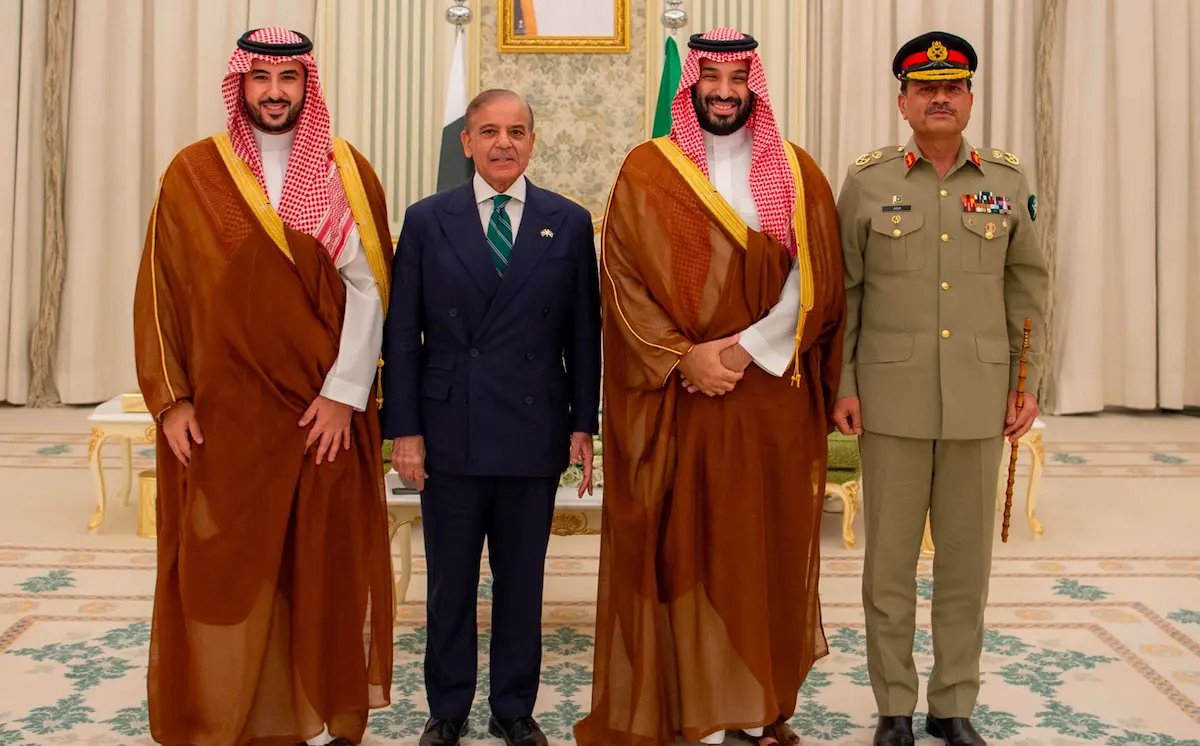
Powerful Pact Signed: Saudi Arabia and Pakistan Unite Against Aggression that any attack on either country will be considered an attack on both (photo-X)
A Historic Pact Signed in Troubled Times
What the Saudi-Pakistan Defence Pact Means for South Asia and the Gulf – In a bold move that could reshape regional alliances, Saudi Arabia and Pakistan signed a Strategic Mutual Defence Agreement on September 17, 2025. The pact declares that “aggression against either shall be considered aggression against both,” marking a new chapter in their long-standing relationship.
This agreement was signed during Pakistani Prime Minister Shehbaz Sharif’s official visit to Riyadh, where he met with Saudi Crown Prince Mohammed bin Salman. The timing is crucial just days after an Israeli airstrike in Qatar killed senior Hamas leaders and disrupted ceasefire talks. The region is tense, and this pact sends a strong message: Saudi Arabia and Pakistan now stand shoulder to shoulder against external threats.
For decades, the two countries have shared military cooperation, economic ties, and religious bonds. But this pact formalizes their defence relationship in a way that could have serious consequences for South Asia, the Middle East, and beyond.
Why This Pact Matters: Strategic, Political, and Emotional Layers
This isn’t just a military agreement, it’s a signal of deeper trust and shared purpose. Let’s break down why this matters:
Strategic Impact
- Pakistan’s Nuclear Umbrella: While Saudi Arabia doesn’t have nuclear weapons, Pakistan does. This pact could be seen as Saudi Arabia gaining indirect access to nuclear deterrence.
- Joint Deterrence: Any attack on Pakistan—say, from India or militant groups—could now draw Saudi Arabia into the conflict. Similarly, threats to Saudi oil infrastructure or territory could involve Pakistan’s military.
- Regional Power Shift: This pact may challenge the influence of other regional players like Iran, Israel, and India. It adds a new layer of complexity to already fragile diplomatic relations.
Political Symbolism
- Unity Among Muslim Nations: The agreement is being celebrated in some circles as a symbol of Islamic unity and brotherhood.
- Message to the West: Both countries have had complicated relationships with Western powers. This pact shows they’re willing to rely on each other rather than external allies.
Emotional Resonance
- For many citizens in both countries, this pact feels like a reaffirmation of shared values, history, and faith. It’s not just about tanks and missiles, it’s about trust.
India’s Dilemma: Strategic Calculations and Diplomatic Tightrope
India, which shares a tense border with Pakistan and growing trade ties with Saudi Arabia, now faces a diplomatic puzzle.
Security Concerns
India’s Ministry of External Affairs issued a cautious statement: “We are studying the implications of this development for national security and regional stability.” That’s diplomatic code for: we’re concerned.
India has fought multiple wars with Pakistan and recently launched Operation Sindoor, a cross-border strike targeting militant camps. Pakistan responded with shelling that killed dozens. Now, with Saudi Arabia pledging to defend Pakistan, India must rethink its military calculus.
Economic Ties at Risk?
India and Saudi Arabia have been strengthening economic relations, especially in energy and infrastructure. Will this pact cool that momentum? Possibly not immediately but it adds tension.
Navigating the Tightrope
India must now balance:
- Its strategic rivalry with Pakistan
- Its economic partnership with Saudi Arabia
- Its broader role in the Indo-Pacific and Middle East
This is a moment for smart diplomacy, not sabre-rattling.
What Comes Next: Risks, Opportunities, and Civic Lessons
This pact opens many doors and some of them lead to dangerous places. But it also offers lessons in unity, resilience, and the power of strategic alliances.
Risks to Watch
- Escalation of Conflicts: If either country is attacked, the other may be pulled into war. That could lead to a wider regional conflict.
- Proxy Wars: Militants or rival states may test the pact by provoking one side, hoping to trigger a response.
- Nuclear Shadow: With Pakistan’s nuclear arsenal in the mix, any conflict could escalate quickly.
Opportunities for Peace
- Joint Peacekeeping: The pact could evolve into joint humanitarian missions or peacekeeping efforts.
- Economic Collaboration: Defence ties often lead to deeper economic partnerships think infrastructure, energy, and tech.
- Regional Stability: If managed wisely, this alliance could deter aggression and promote dialogue.
Civic Lessons
For citizens, journalists, and policymakers, this moment offers a few key takeaways:
- Alliances Matter: In a world of shifting loyalties, strong partnerships can offer protection but also come with responsibilities.
- Diplomacy Is a Civic Duty: Peace isn’t just built by politicians. It’s shaped by public opinion, media narratives, and civic engagement.
- Unity Can Be Strategic: Emotional bonds between nations, faith, history, shared struggles, can translate into real-world strength.
Final Thoughts: A Pact Beyond Borders
The Saudi-Pakistan defence pact is more than a headline; it’s a signal of changing times. It reminds us that alliances are not just about weapons, but about trust, timing, and shared vision. For India, the Gulf, and the wider world, this is a moment to watch closely and to respond wisely.
Also read: Strike in 80 Seconds: India’s Fearsome ATAGS Artillery Puts Pakistan & China on High Alert
Stay informed with the latest news and updates – only on Rapido Updates.